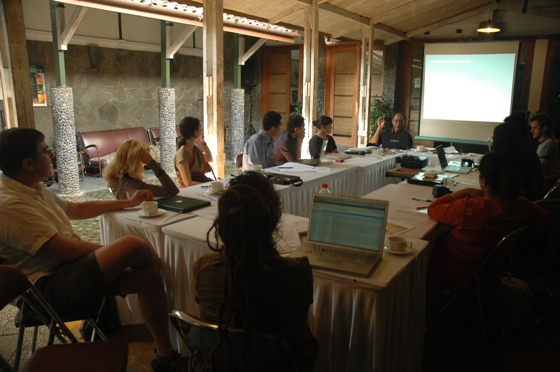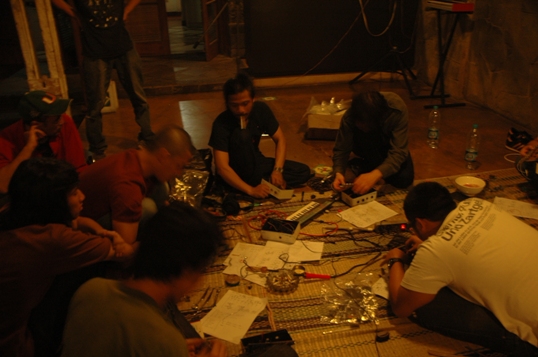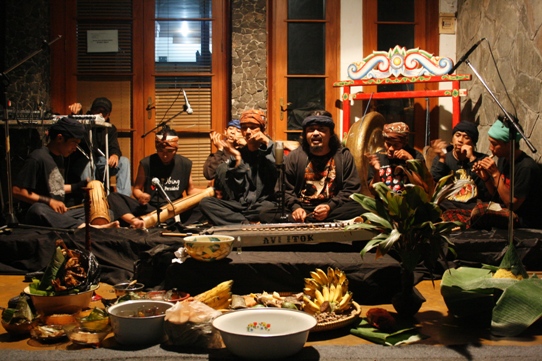Indonesian artists are using new media to rethink urban space
Edwin Jurriëns
The increased freedom of speech and access to consumer communication technology in Indonesia since the late 1990s have been reflected in the remarkable growth in independent art centres. These centres have been set up by youth from diverse backgrounds making use of a variety of creative media, ranging from painting, sculpture and graphic design to video, computer, and mobile phones. These multidisciplinary communities have become important sites for discussion about all sorts of topical issues, including art, media, politics, history, education, gender, health and the environment.
Fully aware of their identity as predominantly urban phenomena, members of the new art communities display a common desire for engaging with urban space. Some of them try to improve the urban infrastructure and economy by promoting local ‘creative industries’, but not at the cost of their primary identity as art initiatives. Partly in reaction against the commercialisation of painting in the booming Southeast Asian art market, they initiate projects and events that cannot be easily commodified, but are primarily meant to generate creative ideas and solutions for urban problems.
The space of shapes
Two major exhibitions in Jakarta in 2010 demonstrated that the development of Indonesian contemporary art since the turn of the century is inextricably linked to the (re-)use, (re-)presentation and (re-)imagination of urban space. These exhibitions, Fixer: An Exhibition of Alternative Spaces and Art Groups in Indonesia and Expanding the Space and Public, were both co-organised by the Jakarta-based art community ruangrupa (space of shapes).
Ruangrupa engages with Jakarta from the art space and community it maintains in Tebet, one of the city’s southern suburbs. This has required strong commitment, for Jakarta’s infrastructure does not make life easy for such communities. Because of the city’s pollution, traffic jams, high costs and low quality of housing, the community relocated three times to more affordable and suitable accommodation within the first ten years of its existence. But it never considered moving from the place where it was first established, Tebet. An essential part of the community’s identity is its interactions with its social surroundings, including dumpling sellers and motorcyle-taxi drivers.
The city of Jakarta has been a theme and/or location for most of ruangrupa’s art initiatives, including its biennial art festivals OK.Video and Jakarta 32 Degrees Celsius. Recurring events in the OK.Video festivals are video art exhibitions, seminars and workshops in various locations in Jakarta. Jakarta 32 Degree Celsius has similar events, but specifically focuses on Jakarta-based students without a formal education in art. It is meant to promote dialogue between students from different institutions and make them aware of their urban environment through art-related activities.
The Lenteng Forum
Another Jakarta-based art community with a strong commitment to themes concerning urban space and social life is Forum Lenteng, based in Lenteng Agung, South Jakarta. The community promotes social engagement in media and art through its video art and short documentaries, participatory video projects, public video screenings and discussions, and media research and publications.
The 2010 Nu-Substance festival included a synthesiser workshop Common Room
Akumassa (I’m the Mass) is an example of their activities. This is a program of participatory video workshops with local communities. Since 2008, workshops have been organised in ten different urban and semi-urban areas in Java, Sumatra and Lombok. After receiving basic video training, the participants are encouraged to record aspects of their daily lives that normally do not reach the mass media. The videos are usually embedded in a blog explaining the background of the filmed story, and posted on the Akumassa website.
Videos by Forum Lenteng’s members have been published by the independent Indonesian DVD label and distributor The MarshallPlan. The videos appeared on a DVD tellingly titled Repelita 1: Urbanisasi (2008). The title is a play on the official five-year economic development plans (Repelita is an acronym for Rencana Pembangunan Lima Tahun) of Suharto’s authoritarian New Order government (1967-1998). Each of the official development plans had its own focus, for instance agriculture, industrialisation or transportation. The video label playfully picked its own theme: urbanisation.
Video Lab and Common Room
Arguably the most comprehensive engagements with urban space have taken place in Bandung, where the local art communities Video Lab and Common Room are based. In 2004, Video Lab organised the Beyond Panopticon exhibition, which was a reference to Indonesia’s first Palapa satellite, launched in 1976. According to Video Lab, Palapa supported Suharto’s nation building efforts by functioning as a ‘virtual control system’. In that sense, it was similar to the panopticon design of traditional prisons, in which prisoners were under surveillance by guards they could not see.
Video Lab attempted to undermine this and other types of control, and go ‘beyond panopticon’, by using television screens in a busy shopping mall to display their own videos in public. The choice of venue provided an excellent opportunity for the art community to transfer their video experiments to a semi-public environment, and transform the mall into a large-scale video laboratory itself.
Common Room is a pioneer in using contemporary and popular art as a means to improve the quality of urban life and infrastructure in Bandung and Indonesia more generally. It is known, among other things, for its involvement in the Bandung Creative City Forum, and for promoting the idea of the creative industry by linking art and culture to local economic development. This concept is now generally accepted and forms an important item on the agendas of Indonesia’s national and regional governments. One key aspect of Bandung’s creative industry is the flourishing of so-called distro, or independent fashion, music, art and craft outlets.
Nu-Substance
Common Room’s concepts and activities are not restricted to the creative industry in a narrow sense, but cover the broader area of urban ecology and environmental issues. In addition to mapping, promoting and actively participating in Bandung’s and Indonesia’s creative businesses, the community has developed art projects and events that approach the creative industry from a more distanced, experimental and/or scholarly perspective. The most important of these is the annual Nu-Substance urban art and culture festival, organised since 2007.
The Sundanese fusion group Karinding Attack played at the opening of the 2010 Nu-Substance festival Common Room
Over the years, the festival’s focus has developed and gradually shifted. Initially, it focused on creating, exhibiting and discussing video and other ‘new media art’ as relatively new phenomena in the Indonesian art scene. In the more recent festivals, explicit connections are made between these forms of art and issues of urban development, and especially the sustainability of social and natural environments.
The Nu-Substance of 2009, titled Resonance; Festival for Open Culture, Technology and Urban Ecology, approached the issues of cultural diversity, the use of Open Source technology and environmental sustainability from an urban perspective. The festival explored the extent to which contemporary art and information and communication technologies could involve ordinary citizens in finding solutions or alternatives to the problems of over-urbanisation.
The festival had presentations of the Babakan Asih Project and the Bandung Oral History Project, two ongoing projects that address the intersections between new media art, local culture, economic development and the urban environment. Babakan Asih is the name of a densely populated suburban area of Bandung. Since 2008, the Bandung-based architect company Urbane has assisted the local community there with ecosystem preservation and management. One of their joint strategies has been the construction of absorption wells to contain rain water and prevent flooding. Common Room’s contributions have consisted of documentation, research, social events and art exhibitions related to environmental issues in the area.
Amongst other experiments, the Bandung Oral History Project has mixed Sundanese oral literature with punk and electronic music. Since 2009, the experiments have been led by the classical Sundanese music expert Iman Jimbot, and have included traditional musicians such as Mang Ayi Ruhimat (Subang) and Abah Olot (Parakanmuncang) as well as the Bandung-based contemporary music ensembles Trah, Karinding Attack!!!, Tcukimay and Ganjoles.
A priority of most of the projects mentioned here is the cross-fertilisation of art and commerce. At the same time, these communities avoid being completely absorbed by the demands of commerce as well as the art industry.
Groups such as Common Room do not set out to create tangible ‘art products’, but instead focus on social and creative processes. These movements seek to provide almost unconstrained ‘playgrounds’ or ‘laboratories’ for critical reflection, creative experimentation and utopian imagination. Although often marginalised in official city development projects, they are invaluable initiatives for measuring and improving the sustainability of Indonesia’s past, present and future urban expansion.
Edwin Jurriëns (Edwin.jurriens@unimelb.edu.au) is lecturer in Indonesian Studies at the Asia Institute, University of Melbourne.


